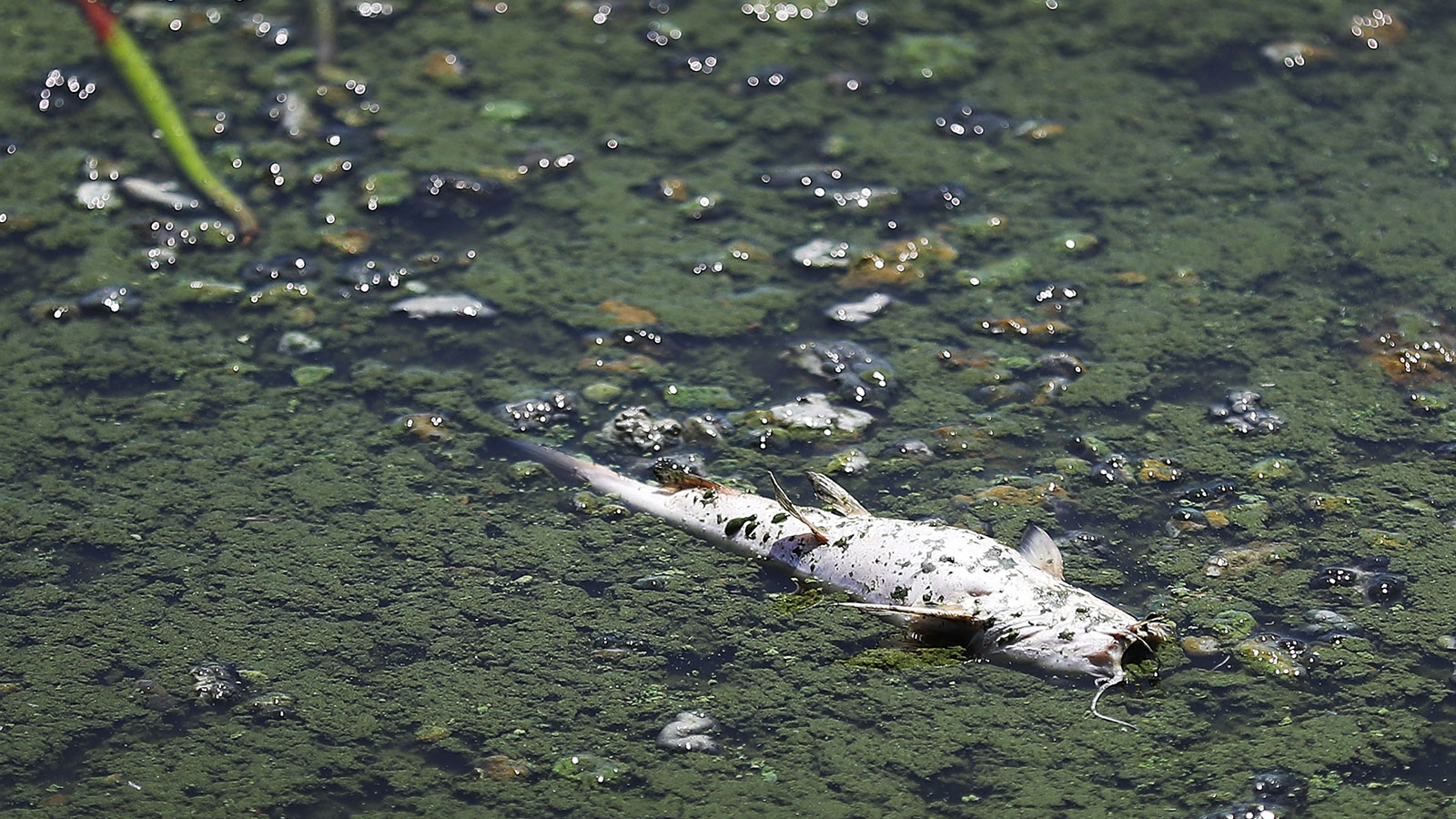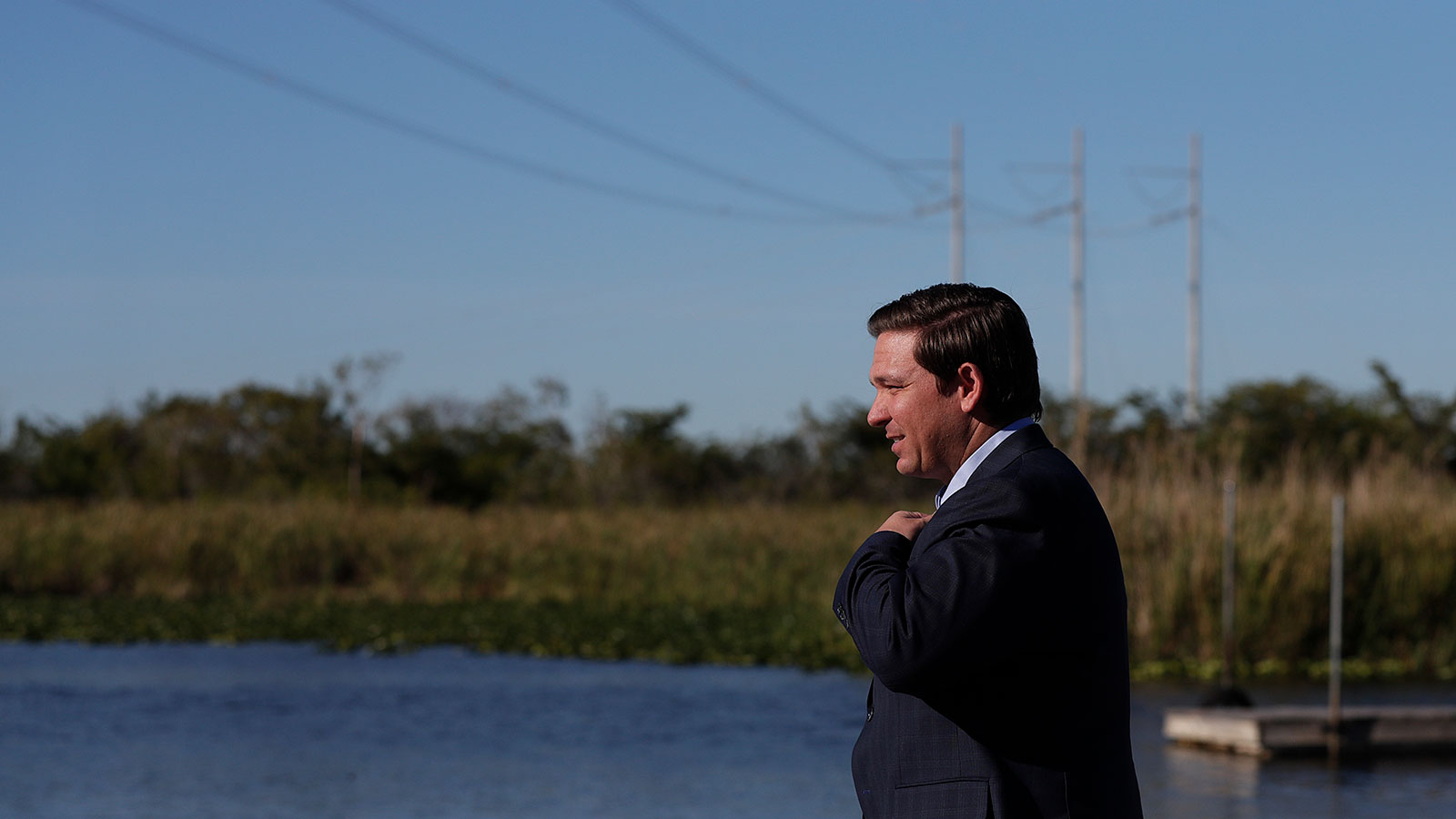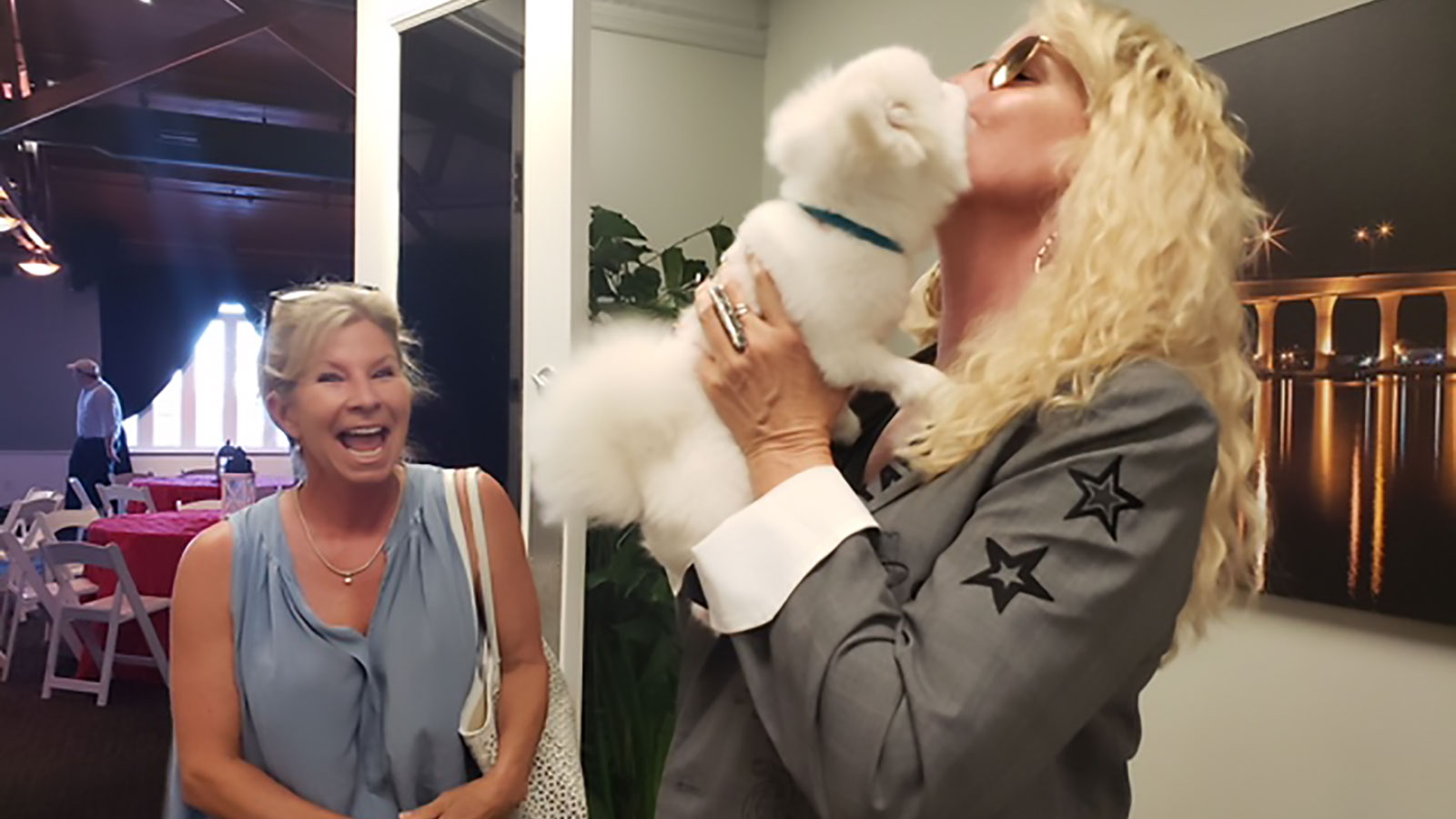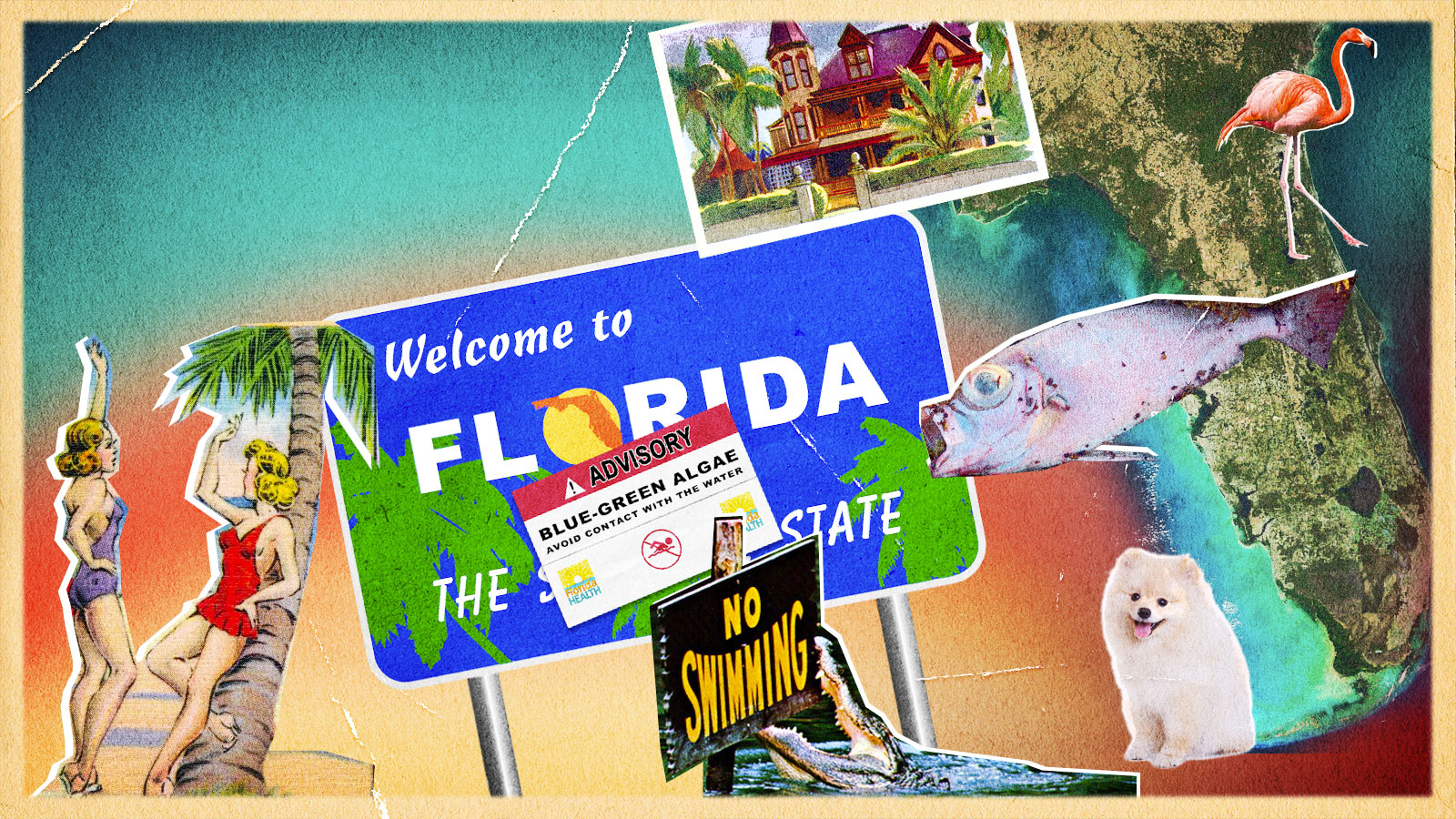It was a sweltering late summer day in southern Florida when Becky Harris took her dogs to run along the bank of the St. Lucie River. Her white Pomeranian, Pandora, was off leash while Kylie, her Rottweiler mix, trotted alongside her. Suddenly, Pandora took off down the grassy hill toward the beach and was soon tearing into a dead fish. Harris tried to yank it out of her mouth, but Pandora bolted under the sea grapes to polish it off.
Within hours, the normally bouncy Pandora was so lethargic that her head fell into her water bowl. Harris took Pandora to the closest veterinary ER, where the little pooch stayed overnight. By the next day, Pandora’s liver was failing. Harris already suspected the cause: the toxic algal bloom. Gunk full of blue-green algae known as cyanobacteria had spewed from Lake Okeechobee into the St. Lucie River near her home in Stuart, a short drive north of West Palm Beach. Even though there hadn’t been any algal deposits visible on the beach that day, a rotten stench hovered around the river’s banks.
Pandora was the first of many dogs in the area to come down with similar symptoms. The next night, another dog arrived at the same ER. Within two weeks, at least six more dogs were sickened and a dead sea turtle washed ashore not far from where Pandora nabbed her poisonous fish. After a poodle named Finn died, an autopsy concluded that microcystin, the toxin in cyanobacteria associated with liver damage in mammals, was the cause of death. Finn also had high levels of the neurotoxin BMAA in his brain.
Before you start to think this is just a story about dogs, consider when it happened — the tail end of last August, during the summer that algae ate Florida. Cyanobacteria filled Lake Okeechobee, Florida’s largest lake, while another pollution-induced environmental hazard, red tide, crept up both of Florida’s coasts, reaching as far north as Daytona Beach. Tourists questioned whether it was safe to take a dip in Florida’s waters. Governor Rick Scott eventually declared a state of emergency. In a few short months, the Sunshine State’s algae crisis went from a rumor residents shrugged off to a top campaign issue in the 2018 election.
As candidates were out surveying the muck — with plenty of time for photo-ops, of course — Harris’ Pomeranian was spending four days fighting for her life in the veterinary hospital. At one point, Pandora was on eight different IV drugs. Harris made plans with an in-home pet euthanasia specialist before the light returned to Pandora’s eyes. Even though the 54-year old Harris calls the turnaround a miracle, she said she was “pissed” that the Army Corps of Engineers discharged the slime that sickened her dog from Lake Okeechobee into the St. Lucie River in the first place. “These discharges, they’re not just bad for our environment,” Harris said. The real-estate property manager worries that the algae is putting people’s health at risk.

Green algae blooms are seen at the Port Mayaca Lock and Dam on Lake Okeechobee on July 10, 2018 in Port Mayaca, Florida. Joe Raedle / Getty Images
Activists, including South Florida’s Sierra Club chapters and Bull Sugar — a nonprofit that protects Central Florida estuaries — believed there was a link between toxic algae and neurodegeneration in animals, and there’s research to back them up. They tried to educate their neighbors even as some continued to boat and swim in the mucky water. But it wasn’t the environmentalists or the dog owners who forced Florida’s politicians to take notice. They started paying attention because the ugly green slop (as well as the red tide) had started damaging businesses, with significant losses reported in the real estate, commercial fishing, and tourism industries.
As the state’s environmental woes took a toll on businesses across Florida, then-Representative Ron DeSantis began telling voters he’d clean it all up if they elected him governor– and he won office, in part, on that promise. The early returns suggest he’s delivering. Despite earning a lifetime score of 2 percent on the League of Conservation Voters’ environmental scorecard during his six years in the U.S. House of Representatives, the Republican has proposed shifts from the pro-business (and pro-polluting) policies of his predecessor.
“For Florida, the quality of our water and environmental surroundings are foundational to our prosperity as a state — it doesn’t just drive tourism; it affects property values, anchors many local economies, and is central to our quality of life,” DeSantis said at his inauguration. “The water is part and parcel of Florida’s DNA. Protecting it is the smart thing to do; it’s also the right thing to do.”
The steps the governor has offered could clean up the state’s waterways, save its coasts, and provide a template for how a Republican executive can do right by the environment in a time when stewardship seems bitterly partisan. “People from both parties are pleasantly surprised,” said Carol Weissert, a political science professor at Florida State University.
Back when Pandora’s condition was touch-and-go in the clinic, DeSantis was hitching his campaign for governor to President Donald Trump’s rising star. He ran an ad that included chanting of the ubiquitous refrain about building a wall and, believe it or not, reading Trump’s The Art of the Deal to his baby.
After a Trump endorsement helped propel him through the Republican primary, DeSantis faced his Democratic opponent Andrew Gillum, the Tallahassee mayor who ran on a progressive platform that included Medicare for All, doing away with the Immigration and Customs Enforcement agency, increasing teacher salaries, and banning assault weapons. It was a stark contrast to DeSantis, who said he would have vetoed the bill that called for stricter gun control in the wake of the shooting at Marjory Stoneman Douglas High School in Parkland. He also supported tightening immigration enforcement and repealing the Affordable Care Act. Hours after he won Florida’s Republican primary, DeSantis remarked that voters would “monkey this up” if they voted for Gillum, a comment that earned him accusations of racist dogwhistling. Soon after, he was sporting a red Make America Great Again cap — but with Trump’s ratings so low in the state, many voters thought Gillum would be a shoo-in.
But Trump’s backing wasn’t the only factor in the election: There was also the slime that was seemingly everywhere. By July, an outbreak of cyanobacteria covered more than 90 percent of Lake Okeechobee. Algal blooms happen when pollution, such as nitrogen and phosphorus from fertilizer, swills with warm water. Historically, the Everglades was a moving, living body of water, hence the nickname “River of Grass.” But construction of a dike system below Lake Okeechobee and roads laid throughout the southern portion of the state have slowed and even stagnated the natural southward flow of the Everglades. Combine that with lax policing of anti-pollution policies, and you have a recipe for ecological disaster.
Toxic blue-green algae can quickly poison dogs like Pandora, but its effect on humans and larger mammals is much slower, to the point that many Floridians have denied the risks for years.
Researchers at the University of Miami knew better. They were already studying the algae’s effects on dolphins by the time the election rolled around. Dead dolphins had been washing ashore during the algae bloom, their brains showing the tell-tale degeneration of Alzheimer’s, Parkinson’s, and Lou Gehrig’s diseases. In their study, published in March, the researchers found high levels of BMAA in the dolphins’ brains, leading them to believe that the neurotoxin, which is produced by the algae, could be to blame for their deaths. The scientists reasoned that all that BMAA had caused the large mammals’ brains to prematurely age, a finding they said “raises concern about the potential risk to human health” for people regularly exposed to BMAA as a result of more frequent algal blooms. Dolphins are in the same part of the marine food web as humans — the top — so the researchers believe eating affected seafood could have similar effects on humans, depending, of course, on how much seafood you eat. Research to find a definitive cause-and-effect link between algae exposure and dolphin neurodegeneration is ongoing. In the meantime, locals say, “Don’t eat the fish from Lake O.”

A dead fish is seen floating in the awful smelling algae in the St. Lucie River on July 11, 2016 in Stuart, Florida. Joe Raedle / Getty Images
Many in Florida blame then-Governor Scott — now the state’s junior senator — for pushing policies that put business first and the environment second, all with a blind eye to how clearly those two are intertwined in the Sunshine State. During his eight years in the governor’s mansion, Scott loosened a variety of protections, creating a recipe for the hell soup served up in the summer of 2018: He cut almost $700 million in funding meant to regulate and protect Florida’s waterways. He repealed a law that required septic tank inspections. He filled the state’s five water management boards with people more inclined toward catering to big business like the sugar industry and seemed to care little about safeguarding Florida’s waters. The South Florida Water Management District, for instance, got involved with a horse-killing billionaire’s scheme to sell Florida’s publicly owned water. Drama, espionage, political fighting and million-dollar lawsuits ensued.
By the end of his term, Scott tried to change his ways. He was running for the Senate, and with Florida’s green gunk splashed all over the news across the country, the environment had become a top issue in his successful race to unseat Democratic Senator Bill Nelson. In his final months as governor, Scott declared a state of emergency to combat the algae. He also ordered an increase in water-quality testing and created a grant program to help small businesses hurt by the bloom. It was too little, too late for Florida’s waters, but for Florida voters, it was just enough to help Scott best Nelson in the Senate race.
DeSantis, although he had tied himself to Trump, also began to embrace the environment. While Trump has proposed slashing the U.S. Environmental Protection Agency’s budget by billions of dollars, DeSantis’s campaign platform included proposals to beef up funding for the state’s environmental agency and initiatives to restore and protect Florida’s waters. He talked about stopping algae-thick discharges from Lake Okeechobee. He opposed offshore drilling and sought solutions for the epidemic of red tide that littered Florida’s beaches with dead fish last year.
“I think human activity contributes to our environment. I have always thought that,” DeSantis said in a September press conference after taking a python-filled, harrowing tour of the Everglades in an airboat. “I’m also not somebody who is on the political left that says if there are more hurricanes, it is because of climate change … I’m not in the pews of the church of the global warming leftists. I’m a Teddy Roosevelt conservationist. It’s just a different analysis.”
And even though his plans called for resilience strategies to prepare coastal cities for rising seas, DeSantis’ public stance stuck to the party line: His platform never mentioned the words “climate change.”
Those two words are what Jason Evans, an assistant professor of environmental science at central Florida’s Stetson University,* calls “the third rail of Republicanism.” Evans is an environmental policy expert who makes an effort to talk to Republican voters and politicians about green issues. “I have talked with Republicans privately who acknowledge the science of climate change but have also said pretty explicitly that they can’t talk about it, because their base voters have been conditioned to say that climate change is something that Republicans don’t believe in.”
Evans thinks climate change shouldn’t be a partisan issue. Though DeSantis might agree, he thinks the governor would never come out and say it. “But actions,” Evans said, “can speak louder than words.”
Florida wasn’t always such an environmental garbage fire.
The Everglades once flowed south from Lake Okeechobee into Florida bay, above the Keys. In the early 1900s, construction projects, including a series of dikes and canals, diverted much of the Everglades’ natural southward flow. Without it, the level of Lake Okeechobee now builds up until the Army Corps of Engineers can discharge it toward the coasts along the St. Lucie and Caloosahatchee Rivers. That doesn’t sound so bad until you consider how polluted Lake Okeechobee is from agricultural runoff, which feeds the toxic algae.
Many Floridians blame much of the water pollution — and therefore the algae problem — on the sugar industry, or “Big Sugar.” Others, including many agricultural scientists, say the issue is more complicated and that a confluence of sources, including septic runoff, have come together to create Lake Okeechobee’s noxious stew. Regardless of the cause, the lake’s water has become prime real estate for toxic cyanobacteria. And whenever the Army Corps of Engineers discharges it toward the coasts, that algae inundates the estuaries, home to hundreds of plant and animal species, and a step away from countless backyards.
Shortly after moving into the governor’s mansion in Tallahassee, DeSantis started laying out steps that he hopes will restore the Everglades’ natural flow as part of a massive plan to clean up Florida’s waters. The plan includes an executive order that sounds like Christmas morning for Florida environmentalists: a focus on green infrastructure, a ban on fracking, more scrutiny of septic tanks, more funding for water monitoring, and a taskforce that would focus on curing Lake Okeechobee of its pollution and blue-green algae woes. DeSantis’ plan also included the appointment of a chief science officer for the state — the first one for Florida.

DeSantis arrives to speak about his environmental budget at the Everglades Holiday Park during a new conference on January 29, 2019, in Fort Lauderdale, Fla. AP Photo / Brynn Anderson
DeSantis hopes this multi-pronged approach can stop the discharges from Lake Okeechobee along with the algal blooms. He’s promised $2.5 billion for Everglades Restoration projects. But perhaps more importantly, the governor is reorganizing the water management districts.
With such a dull-sounding name, Florida’s water management districts don’t sound like they wield too much power. The reality is that they wield enough power to control Florida’s 12,133 square miles of water, an area roughly the size of Maryland. Last year’s bumper crop of algae in many ways can be traced back to crony capitalism practiced by these unelected boards.
The districts are tasked with directing water resources in a way that balances economic growth with the environment. It’s the job of the appointed managers to make sure there’s water when you turn on the tap — and that it’s clean and drinkable. They’re also supposed to grant permits to businesses so they can draw on the water supply in a way that doesn’t harm any of Florida’s delicate ecosystems, especially protected wetlands.
But when Scott started sapping their funding in 2009, it was the environmental protection function that fell by the wayside. The scientists who staffed the water management districts started leaving, and others were forced out as the budgets that paid their salaries dwindled. Then Scott and the water districts changed the way policy was implemented, making it too easy to draw water and pollute it.
“Things got out of whack,” Evans said, pointing to the algae blooms and red tide. “And so DeSantis figured out that being more environmentally minded is going to be a winner in terms of politics in Florida.”
Soon after he took office, DeSantis asked almost the entire South Florida Water Management District, which has jurisdiction as far north as Orlando, to resign. Environmentalists are cheering some of his replacements, including Ronald “Alligator” Bergeron, a former alligator wrestler and state wildlife commissioner. But others are still skeptical. New water managers will mean new interpretations of water policies, which could bring cleaner water to Florida. Or they might offer new justifications for the same policies. Many regulations intended to protect Florida’s water already exist. How they’ve been enforced, if at all, is another matter. Governor Scott had slashed funding for the Florida Department of Environmental Protection, too, and so the agency had very little money to pay for monitoring.
“The way that it works within the world of environmental policy is that if you’re not measuring something, then it doesn’t exist in the eyes of the law,” Evans said. “If you’re going to try to cut down on the enforcement of regulations, what you do is you cut the budget for the monitoring side.”
Cut back enough, Evans added, and “you don’t know when violations are happening.”
DeSantis’ funding package made it through Florida’s Republican-dominated legislature in May, and then some. Lawmakers decided to put more than $680 million toward addressing Florida’s water woes, with $25 million of that specially earmarked for combatting red tide and toxic algae.
“Florida is now on a course towards clean water, a restored Everglades and a healthier environment for generations to come,” DeSantis said at a press conference last month.
For a Republican-led legislature and a Republican governor to turn toward environmental restoration like this isn’t as shocking as it might seem. Even as recently as a decade ago, clean water was seen in the state as sacrosanct, Evans said. “Unlike other areas of the country, there’s a strong conservative tradition here in Florida for actually being pro-environment,” he explained. “If we have clean water, it’s a good idea for beaches and tourism.” Evans thinks DeSantis is trying to tap into that tradition.
Earlier this year, Becky Harris, with Pandora the Pomeranian in tow, met Governor DeSantis when he visited Stuart to announce his plans to combat Florida’s water problems. Harris told DeSantis she had voted for him and had cheered him on from the start of his campaign.
“I was always a DeSantis fan,” Harris said. “You know, a lot of times what candidates say they’re going to do and then what they do are completely different. I didn’t get the sense from him that he was going to be as great a friend to the environment before the election, but wow, I’m pleasantly surprised.”
She didn’t get to talk to him for long, but she did mention Pandora’s near-death experience. The governor said he didn’t know about the dogs. Harris’ story hadn’t spread far enough yet.

Becky Harris and Pandora meet Erin Brockovich. Cristina Maldonado
Having Pandora almost die, while a heartrending experience, inspired her to do something. Harris has been a lover of the environment all of her life — she puts her plastics and papers in recycling bins and is careful with her water and electrical use, behaviors she passed on to her two children. She has always loved going out on the water on a boat or paddleboard, too, but with all the green slime on the water these days, her paddleboard has stayed on dry land. She’s also been a Republican since she started making her own money, first as a nurse, then from a party-rental business she and her husband ran while they were raising their kids, before managing the rental properties she does now. But Harris sees no reason that business should be at odds with the environment.
“Things have gotten so divisive,” Harris said. “Unfortunately, there’s too much of this, ‘Oh, you’re a Democrat, oh, you’re a Republican, so you only think this way.’” To her, the environment shouldn’t be strapped to political parties. It’s a matter of life and death for everybody — Democrats, Republicans, and, of course, dogs.
So now Harris is a crusader. She’s put all of her charm, energy, and ingenuity behind convincing as many people as she can about the dangers of toxic algae. She started a website, toxicdischarges.com, and hands out business cards to everyone she sees. She goes to water district meetings and speaks up. Whenever a politician is in town, she’s ready to take the mic and demand action, and she’s traveled to Tallahassee to try to talk with people in the legislature, the Department of Agriculture, and the Department of Environmental Protection, among other state agencies.
Over the past few months, Harris has realized how complicated the process of regulating the environment in a big state like Florida truly is. On one of her trips to Tallahassee, she came to a realization: “Ag isn’t the whole problem,” Harris said. “Sugar isn’t the whole problem. Septics aren’t the whole problem. Everything needs to be addressed. And people need to stop pointing fingers and just address it.”
Whoever she meets, whether they’re a legislator of just folks on the street, Harris tells them about the dangers of toxic algae. She’s a character. Her voice is bubbly and animated. It’s hard to imagine anyone not taking the time to hear her out. And it doesn’t hurt that she always has Pandora in tow. The little Pomeranian, as spunky as she was before eating that poisonous algae, has become the mascot for Harris’s mission. The pair recently charmed another blonde environmental activist: Erin Brockovich, who is also campaigning for clean water.
With all the problems mucking up our water, the state of Florida sorely needs an environmental champion. It could very well be DeSantis, but maybe what it takes to change so many minds is a stubborn blonde woman and her feisty Pomeranian. After all, politicians have had their chances — at the state, national, and international levels. On the surface Becky Harris and, say, the Swedish teenager Greta Thunberg who has set alight a movement of Generation Z-ers demanding climate action, have little in common. But it could be that, from now on, all our environmental heroes will be the unlikely ones.
*disclosure: I teach creative writing at Stetson University, but I had not met Jason Evans before writing this feature. It was just a happy accident that the expert I needed has an office across the street from mine.




